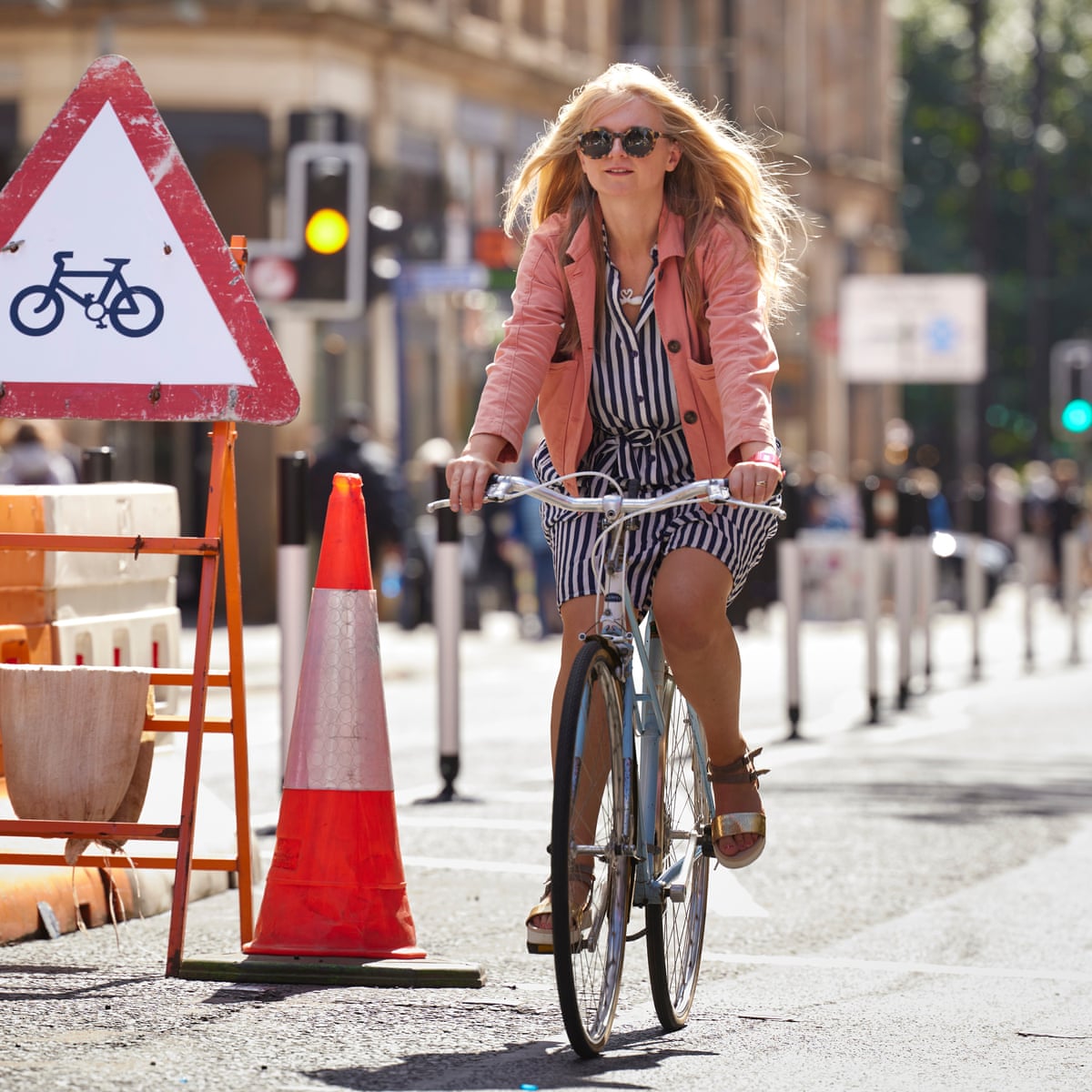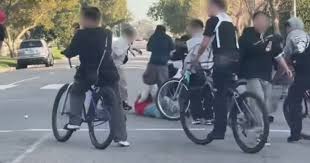In a shocking turn of events that has left the public stunned and questioning the safety of urban spaces, a video has surfaced showing a group of bicyclists attacking a driver in the middle of a busy Miami street—right in front of a Miami police officer. The incident, which has garnered widespread attention, highlights not only the increasing tension between different groups on the roads but also raises serious questions about the role of law enforcement in preventing violent altercations.
The Heart-Stopping Moment
The video, which has quickly gone viral across social media platforms, begins with a seemingly routine scene on the streets of Miami. The footage captures a driver, appearing to follow traffic rules and minding their own business, when a group of cyclists suddenly surrounds the vehicle. What begins as a verbal confrontation rapidly escalates as several cyclists begin to aggressively bang on the car, shouting at the driver and even attempting to pull open the doors.
The situation escalates further when one of the cyclists, visibly enraged, begins hitting the driver’s side window with a bike. The intensity of the attack, coupled with the clear aggression, sends shockwaves through those who witness it. Adding to the complexity of the scene is the presence of a Miami police officer who is seen standing just a few feet away from the altercation. Despite the officer’s proximity, the violent encounter unfolds without any immediate intervention from law enforcement.

The video ends with the bicyclists dispersing, and the driver, visibly shaken, driving away from the scene. The entire event lasts for several minutes, leaving viewers to grapple with the disturbing reality of road rage and its potential for violence.
The Driver’s Perspective: A Day of Ordinary Turns Chaotic
For Carlos, the driver in question, the event was a day that started like any other. A father of two young children, Carlos had just finished his shift at a local business and was heading home when he became the target of the bikers’ anger. “I didn’t do anything to provoke them,” Carlos says, his voice trembling. “I was just trying to get to my family, but they surrounded me, yelling at me. Before I knew it, one of them was hitting my window, and I was trapped in my car.”
Carlos, like many drivers who encounter road rage, had no idea how to react. “I wanted to get out and confront them, but I knew that would make things worse. So, I just tried to stay calm and hoped the police would step in. But nothing happened.” Carlos admits that it was the presence of the police officer, who was close enough to intervene, that left him feeling confused and helpless. “I thought the officer would stop it, but it seemed like they were just watching.”
It wasn’t just the attack that left Carlos shaken—it was the feeling of being abandoned in the face of danger. “I understand that police officers can’t be everywhere, but in that moment, I needed help. I was scared for my safety, and I didn’t know what would happen next.”
Why Did It Happen? Understanding the Root Causes
At the heart of this incident lies a deeper issue: the rising tensions between cyclists and motorists. As cities like Miami become more congested and urbanized, the roads have become battlegrounds where different groups often clash. Cyclists, who are advocating for safer infrastructure and better roads, frequently find themselves in conflict with drivers who may feel frustrated by the presence of bikes on already crowded streets. In some cases, this tension can boil over into aggression, as seen in the video.
Experts suggest that such incidents are fueled by a number of factors:
-
Increased Traffic Congestion: In urban areas like Miami, where traffic is often heavy, both cyclists and drivers feel the pressure of limited space on the roads. Cyclists may feel unsafe on roads designed primarily for cars, while drivers may feel frustrated by the presence of bikes, especially when cyclists don’t always follow the rules of the road.
-
Road Rage: Road rage, an emotional response to perceived offenses on the road, is a serious issue that can lead to violent outcomes. When individuals feel disrespected, threatened, or inconvenienced on the road, they may lash out in aggressive ways.
-
A Lack of Awareness: While most drivers and cyclists understand the basic rules of the road, a lack of awareness and empathy can exacerbate tensions. Many cyclists feel that drivers disregard their safety, while drivers may view cyclists as reckless or a hindrance to traffic flow.
-
Social Media Amplification: The rise of social media has also played a role in the growing animosity between cyclists and drivers. Incidents like the one in Miami can quickly spread across platforms, fueling further divisions and even encouraging copycat behavior from others.
The Role of Law Enforcement: A Missed Opportunity?
The most perplexing and concerning aspect of this incident is the role—or lack thereof—played by the Miami police officer who witnessed the attack. As the altercation unfolded right in front of them, many viewers expected the officer to intervene. However, the officer appears to do nothing during the violent confrontation, leading to questions about law enforcement’s responsibility in such situations.
“People are asking why the officer didn’t step in sooner,” says Maria, a community advocate for safe roads. “We understand that police officers can’t always intervene in every situation, but when something like this happens right in front of you, it’s hard to imagine why they didn’t act immediately.”
The incident has sparked discussions about the role of police in maintaining public safety during road-related altercations. “The presence of law enforcement in these situations could make all the difference,” says Maria. “People need to know that there are consequences for violent actions on the road. If cyclists or drivers know that law enforcement is going to step in when things escalate, maybe they’ll think twice before resorting to violence.”
The Community’s Response and Calls for Change
Since the video was released, the incident has ignited a wider conversation about road safety, public behavior, and law enforcement. Community leaders, cyclists’ rights groups, and organizations advocating for safer streets are calling for several key changes, including:
-
Better Road Infrastructure: Advocates for cyclists argue that cities need to prioritize safer bike lanes and traffic signals that protect cyclists from angry or reckless drivers. Providing clear and safe lanes for cyclists can help reduce friction between the two groups.
-
Increased Enforcement of Road Rage: Many believe that road rage should be treated more seriously, with harsher penalties for those who engage in violent behavior on the road.
-
Better Police Training: In situations like this, law enforcement officers need to be better equipped to handle such tense, potentially violent encounters, ensuring they take appropriate action to protect the public.
-
Public Awareness Campaigns: Raising awareness about the dangers of road rage and encouraging empathy between cyclists and drivers can help reduce tensions on the road.
Moving Forward: A Call for Understanding and Empathy
As cities grow and become more crowded, it’s clear that the relationship between cyclists and drivers will continue to be a sensitive and volatile topic. In this chaotic incident, the victim was not just a driver, but a human being caught in a dangerous situation. The cyclists, too, are part of a community seeking a safer, more sustainable way of navigating urban spaces.
Carlos’s story is a reminder that, behind every traffic conflict, there are real people with lives, families, and emotions. This attack could have easily turned even more violent, but fortunately, Carlos was able to escape without physical harm. However, the emotional toll and the psychological impact of such an event are not easily erased.
As for the cyclists involved, they are also part of a larger conversation about road safety and public behavior. Understanding the struggles both drivers and cyclists face—and fostering empathy between the two—is essential for creating safer and more harmonious roadways for everyone.

